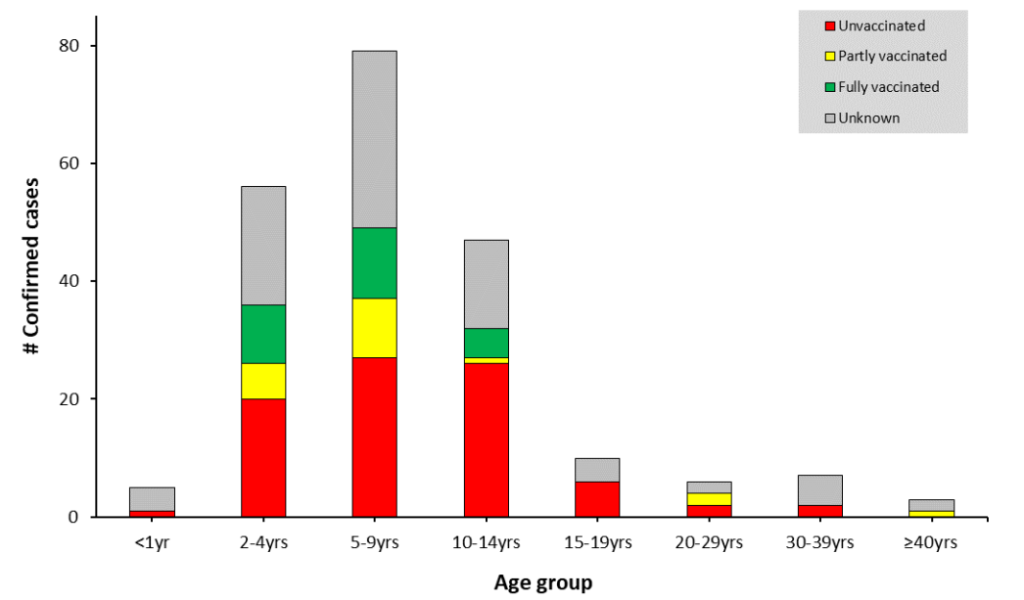NewsDesk @bactiman63
The Nigeria Centre for Disease Control and Prevention (NCDC) reported in an update on the diphtheria situation that 523 suspected and 216 confirmed diphtheria cases have been reported from May 2022 through January 2023.

in Nigeria, epi-week 19 2022 – epi-week 05 2023
Image/NCDC
Eighty-five percent of the confirmed cases occurred among children aged 2 – 14 years.
Of the confirmed cases, 40 deaths have been reported (CFR: 18.5%).
Only 27 (12.5%) out of 216 confirmed cases were fully vaccinated with a diphtheria toxin-containing vaccine.
The NCDC published the following general information about diphtheria:
Diphtheria is a severe bacterial disease caused by the bacterium Corynebacterium species, mainly by toxin-producing Corynebacterium diphtheriae and rarely by toxin-producing strains of C. ulcerans and C. pseudotuberculosis. It manifests as laryngitis, pharyngitis or tonsillitis and is associated with the presence of an adherent membrane covering the tonsils, pharynx and/or nose. Beyond the respiratory symptoms, approximately a quarter of cases may develop heart problems (myocarditis). The mainstay of Diphtheria treatment is antibiotics and Diphtheria antitoxin (DAT).
Transmission
Diphtheria spreads easily between people by direct contact or through the air through respiratory droplets from coughing or sneezing. It may also be spread by contaminated clothing and objects. A person is infectious for as long as the bacteria are present in respiratory secretions, usually two weeks without treatment, and seldom more than six weeks. In rare cases, chronic carriers may shed organisms for six months or more. Effective treatment promptly terminates shedding in about one or two days.
Symptoms
The most common type of diphtheria is classic respiratory diphtheria. The onset of signs and symptoms is usually from 2 – 5 days (could be as high as 10 days) after exposure. Initial symptoms may be mild and include fever, runny nose, sore throat, cough, and red eyes (conjunctivitis). In severe cases, the bacteria produce an exotoxin that causes a thick grey or white patch (pseudo-membrane) on the tonsils and/or at the back of the throat. This can block the airway making it hard to breathe or swallow and causing a barking cough. The neck may swell in part due to enlarged lymph nodes and may frequently confer a bull-neck appearance.
Subscribe to Outbreak News TV on YouTube
The exotoxin produced by the bacteria may also enter the bloodstream causing complications such as inflammation and damage of the heart muscle, inflammation of nerves, kidney problems, and bleeding problems due to decreased blood platelet count. The damaged heart muscles may result in an abnormal heart rate and inflammation of the nerves may result in paralysis. The infection can also affect the skin (cutaneous diphtheria). More rarely, it can affect mucous membranes at other non-respiratory sites, such as the genitalia and conjunctiva.
Complications
Complications due to diphtheria usually in the second- and third week following infection. This includes corneal scarring (aggravated by vitamin A deficiency), encephalitis (more common in older children and adults, 0.1%), diarrhea, pneumonia (a major cause of death) and subacute sclerosing panencephalitis (rare, delayed complication; associated personality changes, seizures, motor disability, progressing to coma and death). Case fatality ratios up to 10% have been reported in diphtheria outbreaks and are higher in settings where diphtheria antitoxin (DAT) is unavailable.
- Dengue in the Americas in 2022: 2.8 million dengue cases reported
- Equatorial Guinea reports nine ‘unexplained deaths’ from an unknown illness
- Nigeria reports more than 50 Lassa fever deaths in January
- Cholera epidemic in North Kivu, Democratic Republic of the Congo (DRC)
- Shigella outbreak climbs to 32 cases linked to Seattle restaurant
- Sweden Salmonella Agona outbreak over, Dozens sickened, Cucumber was the likely cause
- Malaysia dengue cases up 211% in 2023 to date

